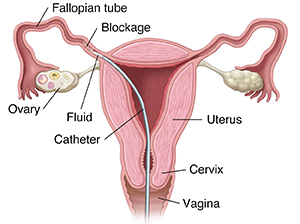Fallopian Tube Catheterization (Recanalization)
Fallopian tube catheterization helps open a blocked fallopian tube. It improves your chances of getting pregnant. The fallopian tubes carry eggs from your ovaries to your uterus (womb). When sperm meets an egg in a fallopian tube, the egg is fertilized. But if the tubes are blocked, that can’t happen. This procedure is done by a healthcare provider called an interventional radiologist.
Getting ready for your procedure
-
The procedure is done a short time after your menstrual period ends. This helps make sure you are not pregnant. If you can't recall the date of your last period, you may be asked to reschedule.
-
You may be given antibiotics to take before and after the procedure. Take them as directed to lower the risk for infection.
-
You may be given pain medicine to take before your procedure. Take it as directed.
-
Ask a responsible adult family member or friend to give you a ride home after your procedure. You won't be able to drive.
-
Follow any other instructions your provider gives you to get ready.
During your procedure
Your provider will go over the procedure with you. In general, here's what you can expect:
-
You will lie on your back on an X-ray table.
-
An IV (intravenous) line may be put into a vein in your arm or hand. This line gives you medicines (anesthesia) to help relax you and keep you from feeling pain.
-
A small metal or plastic tube (speculum) is put into your vagina to hold it open.
-
A thin, flexible tube (catheter) is put through your cervix into your uterus.
-
X-ray dye (contrast medium) is put into the catheter. It flows up into your fallopian tubes. The dye helps your provider see your tubes more clearly on the X-ray images. This test is called a hysterosalpingogram (HSG). It will show any blockage that may be in your fallopian tube. It helps guide the rest of the procedure.
-
The catheter is moved into your fallopian tube.
-
Fluid is injected through the catheter into the tube. This helps to clear the blockage. The catheter may have a small balloon or wire on the end. The balloon can be inflated to help clear the blockage. The wire can also be passed to help clear the blockage.

After your procedure
Call your healthcare provider if you have any of these:
Schedule a check-up visit with your healthcare provider, or as directed.
Risks and possible complications
All procedures have some risk. Possible risks of fallopian tube catheterization are:
-
Small hole (perforation) in a fallopian tube
-
Pelvic infection
-
Problems from the X-ray dye, such as an allergic reaction or kidney damage
-
Tubal pregnancy, when a fertilized egg stays and grows in a fallopian tube
-
Radiation exposure to your reproductive organs, but the risk from this is low
-
Fallopian tubes that get blocked again, which may call for another procedure
Online Medical Reviewer:
Deepak Sudheendra MD
Online Medical Reviewer:
Louise Cunningham RN BSN
Online Medical Reviewer:
Raymond Turley Jr PA-C
Date Last Reviewed:
12/1/2021
© 2000-2024 The StayWell Company, LLC. All rights reserved. This information is not intended as a substitute for professional medical care. Always follow your healthcare professional's instructions.